Lakulisha-Pashupata (Philosophy and Practice)
by Geetika Kaw Kher | 2012 | 86,751 words
This study discusses the dynamics between the philosophy and practice in the Lakulisha-Pashupata order. According to the cave temples of Elephanta and Jogesvari (Jogeshwari), Lakulisa was the 28th incarnation of Shiva, and Pashupata Shaivism his doctrine, of which the Pasupatasutra represents the prominent text detailing various ritual practices (v...
Mukhalingas and esoteric meanings
Mukhalingas are a variety of Manusha-lingas bearing one or more sculptured faces of Siva on it.Most of the Agamas and Tantras provide detailed descriptions about making of a mukhalinga and hence their importance is stressed upon. Summarizing the essential points from these texts Rao[1] writes:
“The substance of these is that a Mukhalinga should be made on the pujabhaga of the Savrvsama-linga and that it might have one, two, three, four or five faces corresponding to the five aspects, Vamadeva, Tatpurusha, Aghora, Sadyojata and Isana of Siva.”
He further suggests that the number of faces on the linga were equal to the number of doorways of the garbagrha, Hence if there was only one doorway, ekamukhalinga was established and if there were four then Caturmukhalinga was established.
An important ekamukhalinga is housed in The Philadelphia Museum of Art. Interestingly it shares the realistic depiction of gudimallam linga and other free standing lingas belonging to pre Christian era.Here an incised rim circles the nut just above the central fold and above this point emerges the human head.On basis of the style Srinivasan[2] dates it to 1st BCE which seems quite plausible.
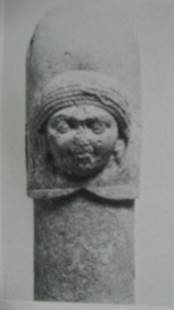
[Illustration 50. Ekamukhalinga, Pre Kusana, 1st BCE, Mathura (Philadelphia Museum of Art)]
Another interesting Pre-Kusana ekamukhalinga comes from Aghapur (Bharatpur District, Rajasthan).Carved out of mottled red sandstone it echoes the similar realism seen in the early lingas from Mathura.Siva’s face carved on the shaft is seen wearing an elaborate turban and which as one can see in the table is showing the east face displaying the kingly characteristics of the lokapala Indra.
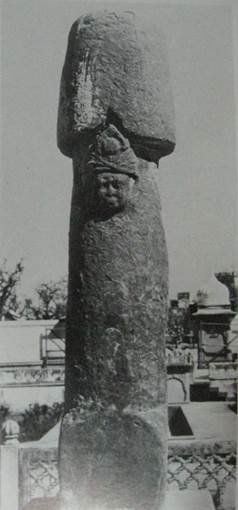
[Illustration 51. Ekamukhalinga, Pre-Kusana, Aghapur, U.P (Govt. Museum Bharatpur)]
An ekamukhalinga, showing Siva as jatamukuta is carved on an architectural fragment presently housed in State Museum, Lucknow. On the basis of style it can be dated a little later than the earlier ones discussed above, i.e c. 1st CE,possibly the early Kusana period. Still the nut and the shaft are seen visibly differentiated with a help of a deep line which goes round the linga. The top portion is decorated with a patterned band, tied as if to secure Siva’s face to the linga.Like all the early linga forms this too is free standing and is installed upon a brick platform, situated before a spreading papal tree.Two worshippers are seen on the right standing infront of a broken figure.
The fact that a number of “mukha-lingas “are found from Thailand as enumerated by Indrawooth[3] ishows that this cult was popular in the area around 5th -6th C.. A number of Siva lingas have been reported from Southern Thailand especially from “Chaiya”, “Nakhon Si Thammarat” “Songkla” and “Pattani”.Besides these sivalingas the existence of Saivism on Peninsular Thailand during this period is well supported by the 6th C. Sanskrit inscriptions from “Khao Chong Khoi” in “Nakhon Si Thammarat” province. The commercial trade contact hugely responsible for exchange of ideas between South India and Thailand were well established from Pallava period (6th C.) onwards though there are earlier scattered proofs of contact with east and central India.
In her extensive article on “Saivism in early southern Thailand she has meticulously recorded the Saivite archelogical remains in the area and also has refered to some important inscriptions.
She has also thrown some light on Sivalinga cult and the number of Sivalingas found in the said region. She concludes her article with,
“The predominance of Sivalinga and Siva images as well as Saiva sacred places indicates that Saivism was flourishing in the peninsular Thailand during Srivijaya period37.”
Another enlightening article on the subject is by Prapandvidya[4] on “Saivism in Thailand as recorded in Inscriptions and old documents from 6th c ad to early Ayudhya period”. The detailed study of these inscriptions and their bent towards Saivism is clearly pointed by the scholar. He further observes that from the reign of King Bhavavarman I till king Jayavaraman VII’s accession to the throne, the major religion in the north eastern region of ancient Thailand was Saivism.
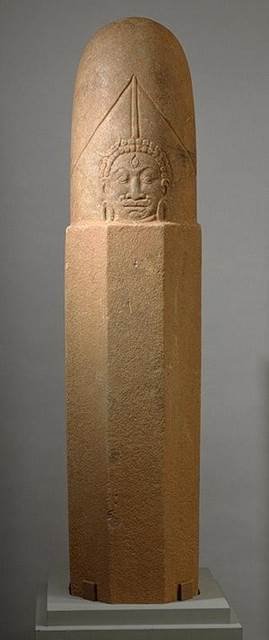
[Illustration 52. Ekamukhalinga, Mon-Dvaravati Period, 8th CE, Thailand]
In case of Caturmukhalinga in addition to the four visible faces there is one supposed to be on the top which is usually not carved and which represents Isana aspect of Siva. Tatpurusa is represented by the east facing face and Aghora by the southern one. Sadyojata is represented by western face and Vamadeva by the northern one.In the case of four faces, these should be attached to a body which ought to be represented to the level of the chest.
Such a representation can be seen clearly in Pancamukhalinga from Bhita. Joshi39 opines that:
“Three of the four faces on the caturmukhalingas–the terrifying (aghora), the shaven (mundin or yogin) and the turbaned (usnisin)are male, while the fourth one is female (vama). In Post Kusana sculptures turbaned and shaven faces disappear and are substituted for by normal faces”
Epic and Puranic mythology provide a mytho-poetic explanation of emergence of this interesting form of Siva. Mahabharata, a storehouse of interesting and valuable myths narrates the story of celestial nymph Tillotama who was going around in the assembly of gods. Bewitched by her beauty Siva didn”t want to take his eyes off her even for a moment so he developed four faces, one at each cardinal point to enjoy an unimpeded view of Tillotama.(Adi-parvan,210. 23-26,605-6). Another reason is provided in Anusasan-Parvan of Mbh where Siva appears to explain this form saying that with his eastern face he rules as Indra, the western one is his normal face, his southern face is meant for destruction and that with his northern face he converses with Uma. Joshi[5] suggest that here Siva has taken over the function of four lokapalas.
| Direction | Lokapala | Function | Aspect | |
| East | Indra | King and Administrator | Turbaned | Usnisin |
| West | Varuna | God of water and fertility | Normal | Saumya |
| South | Yama | God of death and destruction | Terrifying | Aghora |
| North | Soma/Kubera | God of beauty/God of wealth | Feminine | Vama |
The Suta Samhita also conveys the notion about the nature of the five aspects of Siva represented by the five faces.Thus Isana is ether (akasa), Tatpurusa air (vayu), Aghora fire (agni), Vamadeva water (jala) and Sadyojata earth (bhoomi). The text states that the universe is pervaded by the “Panca Brahma” and the person who is able to realize this attains liberation from bondage (is free of pasas which bind him to Sansara) (choubey p 36). In his Brahma Mimamsa-Bhasya Srikanthasivacarya interprets these five faces as representing five senses viz. Sadasiva is sound (sabda), Isvara touch (sparsa), Rudra form (rupa), Visnu taste (rasa), and Brahma smell (gandha).
Now the esoterism of the Mukhlingas may be traced in the Narayanopnisad which was largely used by the Pasupatas for their sacred hymns.
Pasupata-sutra preached these mantras to be used as Bija-Mantras for sadhana.
Sadyojatam prapadyami Sadyojataya vai namah /
bhave bhave natibhave bhajasva mam bhavodbhvaya namah/Vamadevaya namo jyesthayah namah sresthaya namo, Rudraya namah, kalaya namah kala-vikaranaya namo balavikaranaya namo bala-pramathanaya namah sarvabhutadamanaya namo manonmanaya namah//
Aghorebhyotha ghorebhayo gora-ghora-tarebhyah /
sarvatah sarvasarvebhyo namasti-astu Rudra-rupebhyah//Tatpurusaya vidmahe Mahadevaya dhimahe tan-no Rudra prachodayat//
Isanah sarva-vidyanam-isvarah sarva bhutanam brahmadhipatir brahmanodhipatir
- Brahma Sivo’astu Sadasivom
These are hymns to Siva in five different aspects, each with a certain specific attributes. Thus Sadyojata is conceived of as Bhavo”dbhava, similarly Vamadeva is given nine attributes as suggested by the terms Jyestha, Srestha etc. Aghora is invoked as having two attributes, Ghora and Ghoratara. Mahadeva and Rudra are the attributes of Tatpurusa. Isana is addressed as being the supreme lord of learning, of animate objects, of the Vedic knowledge and also of Brahman, as Sadasiva. It is from Sayana’s commentary[6] on these verses that we know these five mantras were addressed individually to five faces of Mahadeva by those who aspired for enlightenment and that four faces of the lord were turned to four cardinal directions and the fifth one towards the sky. Such esoteric form of worship was mainly followed by ascetic aspirants with all its philosophical significance. Sayana does not suggest any reason for emergence of these five faces, he simply says that the Lord assumes such physical forms only to show mercy to his devotees.
Classifies Pasupata-sutra into five sections each ending with an exhortation to meditation eg. Bhasya on sutra 1. 8 says, “atra idam Brahma japet-japyam nama….”.But Kaundinya’s bhasya does not give any idea of the iconographic form associated to these invocations.The attributes of Siva in these mantras are explained in this commentary and are invoked in their formless abstractions with stress laid on the concept of Brahmans (panchbrahma).Though Kaundinya does not clearly talk about panchmukhas (five faces) but from his bhasya on sutra 1. 9 it is clear that though Mahadeva has faces turned to other directions Pasupata-sutra is only majorly concerned with the Daksinamurti. In the earlier sutra 1. 8 he states distinctly that the Pasupata disciple should invoke the image of Mahadeva on the southern side i.e. the southern face of the image of the Lord.The icon Daksinamurti is known from its various depictions as representing a teacher and its no wonder Siva was worshipped in this form by the aspirants of Lakulisa-Pasupata system, who combine the aspect of bhakti with jnana (jnanottar bhakti).
The importance of certain Saiva images as abstract meditational devices has been hinted upon by Maxwell[7] and he compares them to a mandala. He classifies some conjoined anthropomorphic figures in this group and he believes they are intentionally depicted in an unnatural manner.
The first image to be discussed is the so called “Nand Linga”and regarding this Maxwell[8] observes:
“Here we have a sculpture that is visually analogous to my definition of meditation with its interconnected disciplined stages (the emanatory gods) linked by a continuum (the column) leading to transcendence (the freedom of the top four figures around a domed apex-the dome being the symbol of universality, facing, as it does the entire horizon and all angles of space leading to the zenith”
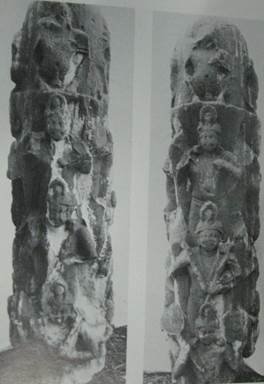
[Illustration 53. Nand Linga, Kusana, 2nd -3rd CE,Rajasthan]
Interestingly Maxwell’s observations sound as abstract as most of the Sanskrit texts on the subject.He reads similar functions in the Siva image from Parel.
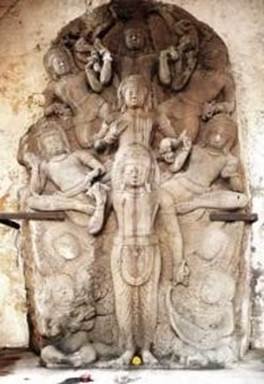
[Illustration 54. Saiva heptad, Candikadevi Temple, Barh Mata, Parel,(Bombay), Maharashtra, 6th CE]
Kramrisch[9] too considered this panel as an important discovery and observed:
“The image from Parel is based on meaning of lingam, of Yaksa and yoga power. It visualises Siva not with the cosmical suggestiveness of the Nataraja image. This shows Siva in this everlasting activity beheld from without. The image from Parel shows Siva realised from within his state of power”
The importance of Linga in this system is stressed upon in Pauranic Eklingjimahatmya datable to Kumbha’s rule C 15th CE translated by Premlata Sharma in hindi.First four chapters of the text narrate the reasons behind the manifestation of Eklingji. Interestingly the myths of Daruvan and birth of Skanda are narrated in third and fourth chapters of the text.
Sharma[10] writes (I have transliterated it from hindi pg 8,9)
“On being asked by Saunak about the significance of Medhpat,(Mewar) Suta answered: In the central region of the Jambudweep there was a forest named Daruvan inhabited by various rishis. Once Siva and Parvati were passing through the forest and playfully Parvati asked Siva to seduce the pious wives of the rishis.Siva refused to comply with her whim and warned her of the Bhramtej with which Rishis could curse them but Parvati remained adamant. So Siva took a form of an extremely handsome man and started roaming in the forest.When the rishi patnis saw the handsome youth they were taken over by passion and were completely enchanted. Siva soon became invisible causing the hapless women to faint.Once these women regained consciousness they began to look for Siva like allover,driven mad by their passion. Rishis were shocked to see their pious wives in a complete state of abandon and through their mental powers realized Siva’s game.Getting angry they unanimously cursed Siva’s linga to fall on the earth”
Hence here we see the connection between linga and phallus is established completely.Now it’s the fifth chapter of the same text which talks about the manifestation of Eklingji[11] .
Here for the welfare of the gods cursed by herself, Devi asked the Siva linga to fall in the beautiful kingdom of Mandhata.The linga would then enter the pataloka (netherland) and will only emerge on being meditated upon by Kamadhenu. All the gods cursed to turn into stone will settle around this linga in their personified forms and the” thief of my womb”Ganga will flow there as “Kutila”.All important pilgrim places will gather around this linga and I too will be manifested there in the form of Vindhyavasini on the banks of Kutila.
Eight Chapter narrates the manner in which Kamdhenu made linga emerge out of the bowels of the earth[12] .
On reaching the spot Kamdhenu filled the void in which the linga had fallen with her milk. Due to her maternal care and love linga emerged out of the hole, floating on the milk and became famous as Eklingji.(p 10)
In chapter nine its clearly stated though Siva was ekalinga but due to devotion of various beings he became Bahu-linga in various aeons. In Satyuga due to Indra, in Treta yuga due to Nandini-dhenu, in Dwapar due to Takshak and in Kaliyuga due to Bashap-Harita.
Troubled by Vrtrasura gods invoked Narayana. Visnu adviced them to cheat the demon in believing that the gods were on his side and after gaining his complete faith to kill him. The gods did the same and finding the right occasion killed the demon on sly. But after killing the demon Indra incurred the sin of Brahmhatya and asked Brhspati to suggest ways of getting rid of the terrible sin. The latter asked Indra to worship Eklingji. Indra came to Nagahrda and first worshipped goddess Vindhayavasini.When the goddess asked him for a boon,Indra asked to be free of sin. Devi directed him to invoke Eklingji which required austere tapa (ugra tapa).Indra dug a lake with his vajra and Eklingji was pleased and absolved him of his sin and declared the “Indra saras” to be a pious pilgrimage site.
This incident reminds one of “Pasupata vrata” mentioned in Mrgendra Agama. The text was written in the form of a dialogue between Harita and his disciples. Indra after killing Vrtrasura incurs brahmhatya and praised Visnu with 1000names (visnu sahastra nama) along with various rites, recitations and rituals.Visnu gave him a “Narsimha cavaca” and asked him to adore Siva in that attire.Here Indra takes up Pasupata vows and adores Siva for thousands of years. (translated from the French introduction to the version found in Puddukotai). Such myths connect the concept very strongly with Vedas. Pasupata-sutra also substantiates this in sutra 4. 10,
P.S. 4. 10 Indrova agre Asuresu Pasupatamacharat
Coming back to Pu.EKM the last part of the 10th chapter gives an interesting story of Harita-rashi and Bashapa.
In Kaliyuga both Nandi and Chand were born as Harita and Bashap, the preceptor and the aspirant.Both got together near Ekalingji and worshipped the lord. Harita performed austere and harsh tapa while Bashap served his guru and Ekalingji both. On being propitiated Devi Vindhyavasini advised Harita to write a prose in praise of Siva.Harita wrote a beautiful piece and Siva was pleased and Harita for a boon. Harita asked Siva to bless him with the ability to enter the Siva’s abode with his physical body intact and Bashap asked to become the king of Medhpat (Mewar). Siva complied with their wishes.
This incident extremely important for explaining the history of Mewar finds parallel in various local legends which I have tried to summarize:
The king of Nagahrda was killed by his enemies and his pregnant wife did not commit Sati for the sake of the unborn child. To escape the enemies the queen disguised herself and her son and took refuge in a Brahmin household. The child was called Bappa and on growing up took to serving the Brahmin who had given refuge to him and his mother.Meanwhile his Kshtriya nature made him excel at the art of archery and weaponary.Meanwhile the Brahmins wife noticed that one of her cows was not yielding enough milk and suspected Bappa of drinking her milk. Bappa who was dejected on being blamed decided to find out the reason. He started keeping an eye on the cow and saw that while grazing she stops at a spot and milk automatically oozes out of her.Bappa was quite surprised. Nearby he saw Acarya Harita,an ascetic deep in meditation and out of reverence cleaned his surroundings. He began to serve Harita everyday and inretun the ascetic instructed them in sacred lore of Siva and one day harita asked him to dig the spot where the milk oozed out of the cow. Bappa and his friends were surprised to find a siva linga under the earth. That Sivalinga was adored as Ekalingji and bestowed the boon of moksa on Harita and Kingship on Bappa.
What is quite significant and connects this motif quite strongly to Pasupata order is its similarity with myth preserved in Gopala Vamshabali of Nepal. It mentions that a cow used to spill her milk at a particular mound in Mrgasthali forest and was once notices by a cowherd of Kirtipur named Nema Gopala. Nema was surprised to witness the act and decided to unfold the mystery by digging the mound. He found a “jyotirling” hidden under the mound but was soon burnt to ashes by the heat of the linga. After his death Ne-Muni, the well known ascetic of that area installed the son of Nema Gopala as the king of Nepal[13] . The parallels between both legends are unmistakable and the connection with kingship raises interesting questions about the role of PasupataAcaryas in the royal set-up and might throw light on the later Rajaguru tradition. As we know Nepal in connected with the worship of Pasupati since a long time and till this day the temple of Pasupati exists on the banks of Bagmati river and commands great devotion.Nepal Mahatmaya of Skanda Purana preserves the myth of formation of this site. It says that Siva was highly taken in by beauty of the forest and started roaming around in form of a deer with golden horns and that is why the place began to be called as Mrgasthali. As other gods got to know about this he left his deer form and returned back to Kailasa but not before installing himself in this area as Pasupati. The passage here could very well be talking about the linga which was installed here and according to Gopala Vamshabali can be dated to 1st CE.

[Illustration 55. Ekamukhalinga, Mrgasthali, Nepal, 6th CE.]
The worship of Siva linga was popularized around Gupta period when the Puranas began to establish that the linga represents the Nirguna state of Siva like Para Brahman of Vedas. A repertoire of mythological literature emerged around the symbol to confer multiple meanings on it, meanings which lay people could understand,which required no ascetic initiation to understand. Mythology provided the pivot around which the symbol attained apparently simplified meanings quite different from it’s earlier esoteric and abstract meaning.
Footnotes and references:
[1]:
Rao Gopinath p.64
[2]:
Srinivasan p.34
[3]:
[4]:
Prapandvidya, “Saivism in Thailand as recorded in Inscriptions and old documents from 6th c ad to early Ayudhya period” evidence” in “Sahrdaya, Studies in Indian and South East Asian Art in honour of Dr. R. Nagaswamy” Ed by Baumer Bettina, Misra R.N.,Prapandvidya Chirapat and Handa Devendra, Tamil Arts Academy, 2006 p 62
[5]:
Ibid p.52-53
[6]:
Rgveda-Samhita Srimat Sayanacharya virchita bhasya-sameksa Ed. by N.S Sontakke, Published by Vaidika Samsodhana Mandala, Pune, 1972
[7]:
Maxwell, T.S. Saiva Images as Meditational Constructs p. 64-65, in Meister M ed.DOS p.
[8]:
Ibid p.66
[9]:
Kramrisch Stella “Indian Sculpture”, Philadephia, 1960, p 176
[10]:
[11]:
Ibid. p.10
[12]:
Ibid. p.10
[13]:
Encylopaedia of Saivism, By Swami Parameshwaranand, 2004 (Pasupatinatha)
